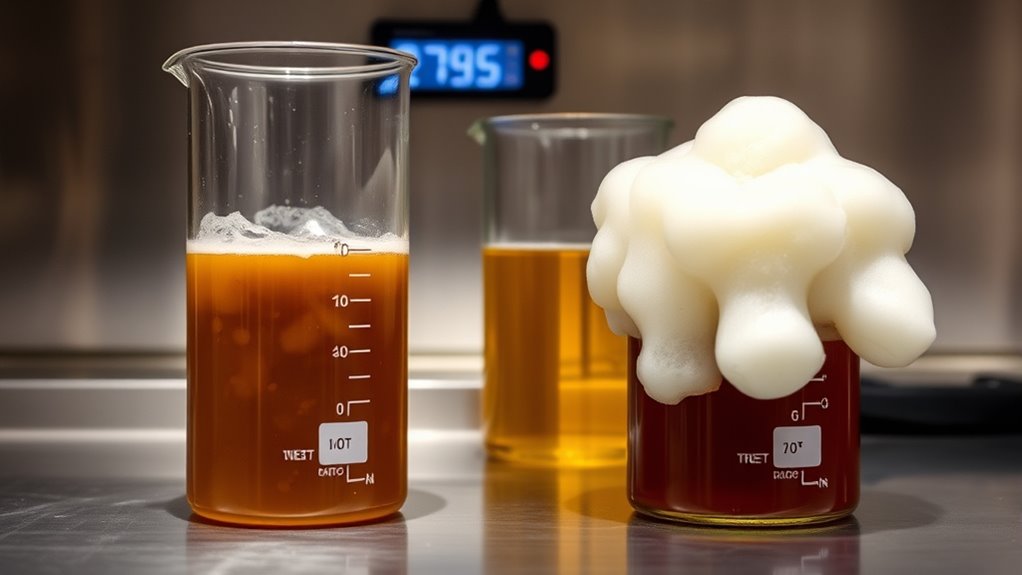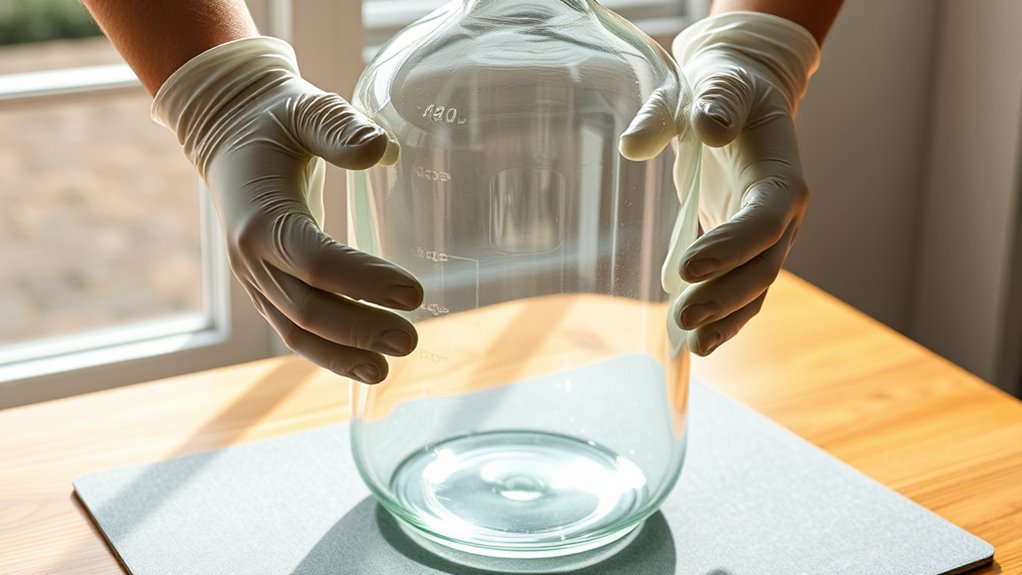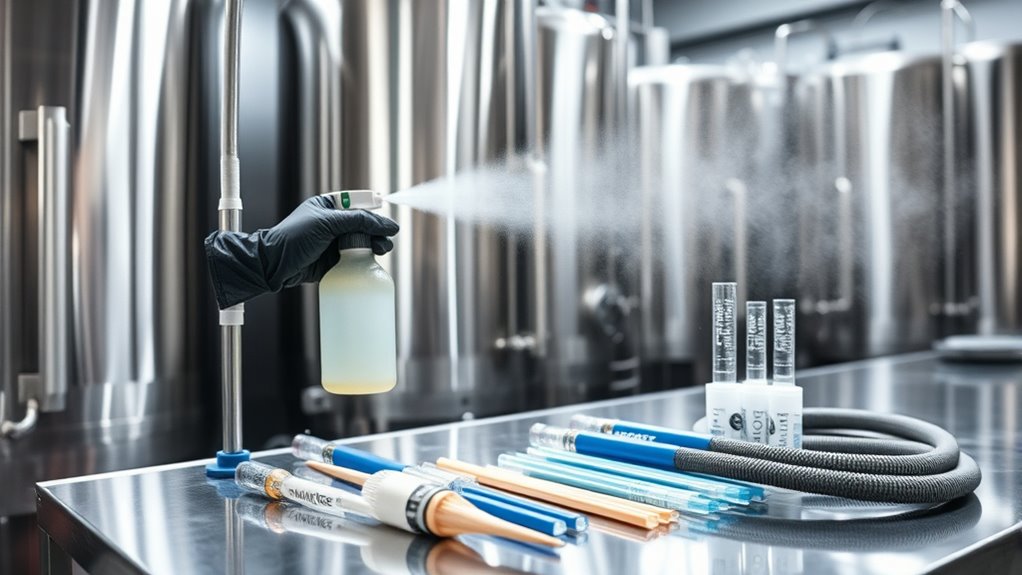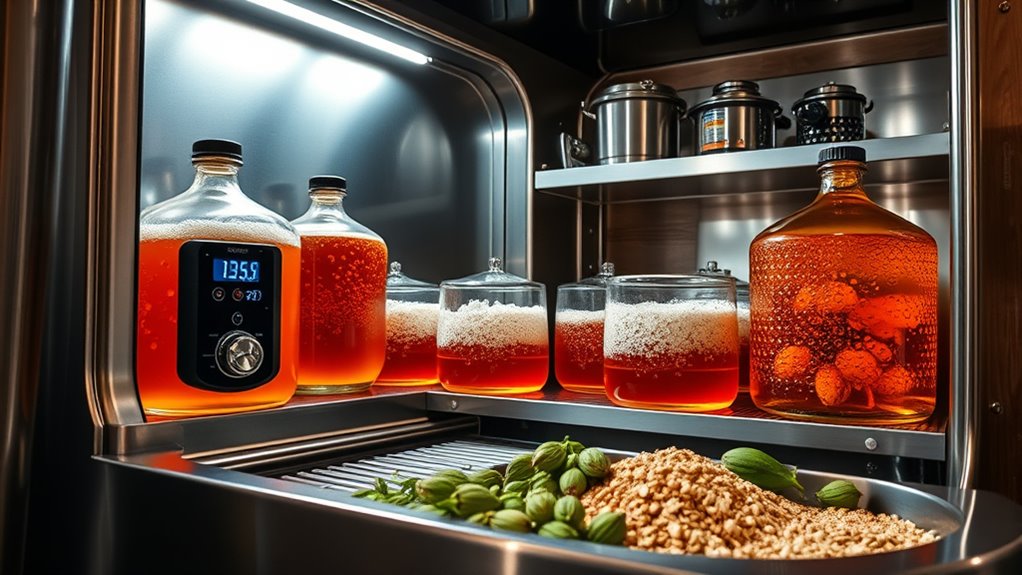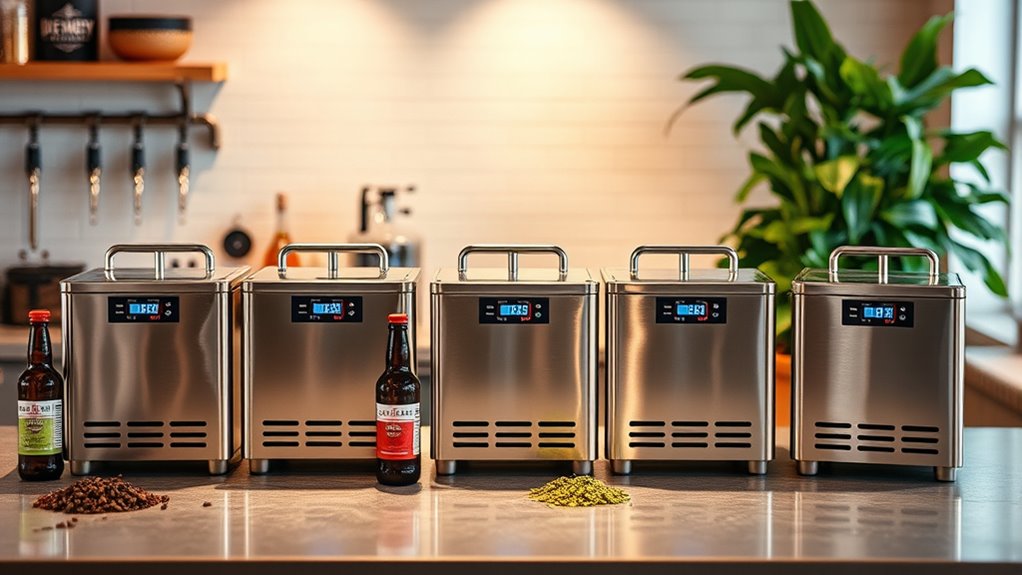Safe yeast handling is essential to prevent brewing disasters. First, verify yeast is stored properly in airtight containers at cool temperatures between 2°C and 4°C, which helps maintain viability. Second, clean all brewing equipment thoroughly to eliminate contamination risks. Remember to pitch healthy yeast at the correct temperature and provide adequate oxygenation. Finally, monitor fermentation conditions like temperature and specific gravity closely. Adhering to these practices helps guarantee successful fermentation and quality beer. You’ll discover more tips for effective yeast management ahead.
At a Glance
- Proper yeast storage conditions prevent contamination and maintain viability, reducing the risk of off-flavors and fermentation failures.
- Clean and sanitized brewing equipment eliminates unwanted microbes, ensuring the desired yeast strains thrive during fermentation.
- Monitoring yeast vitality before pitching ensures healthy yeast, which is crucial for successful fermentation and product quality.
- Regular temperature and oxygen level checks during fermentation help prevent yeast stress and sluggish fermentations, leading to improved brewing outcomes.
- Implementing quality control systems throughout the brewing process allows for early identification of yeast health issues, preventing potential disasters.
Importance of Yeast Health in Brewing
Yeast health is essential for successful brewing, as it directly impacts fermentation efficiency and the overall quality of the final product. Effective yeast management involves providing essential nutrients—like sugars and nitrogen—while monitoring temperatures to guarantee ideal growth.
High temperatures can increase nutrient demands, whereas low temperatures slow fermentation. Regularly evaluating yeast viability through microscopic examination helps identify problems early, preventing sluggish fermentations and off-flavors. Additionally, maintaining low pH levels can help suppress wild yeast, ensuring that your desired yeast strains thrive.
Quick pitching of healthy yeast into sterile wort minimizes contamination risks. By focusing on these key areas, you can enhance fermentation performance and create a consistently high-quality brew.
Helpful Hints:
- Test yeast viability regularly.
- Maintain stable temperatures.
Optimal Storage Conditions for Yeast
When storing yeast, it’s crucial to maintain ideal conditions to guarantee its viability and effectiveness in brewing.
Suitable storage conditions for yeast include using airtight, sanitized containers, ideally under CO2, and keeping them in a cool environment between 2°C to 4°C. This temperature range preserves yeast cells and prevents rapid cooling from higher temperatures, which can harm yeast strains.
For optimal yeast storage, use airtight containers under CO2 and maintain a cool temperature of 2°C to 4°C.
Regularly monitor these conditions to avoid autolysis, which leads to off-flavors and infections. Using high-quality yeast brink kegs can enhance storage life, ensuring better fermentation performance.
Helpful Hints:
- Check temperature regularly.
- Use CO2 for storage.
Cleanliness in Brewing Equipment
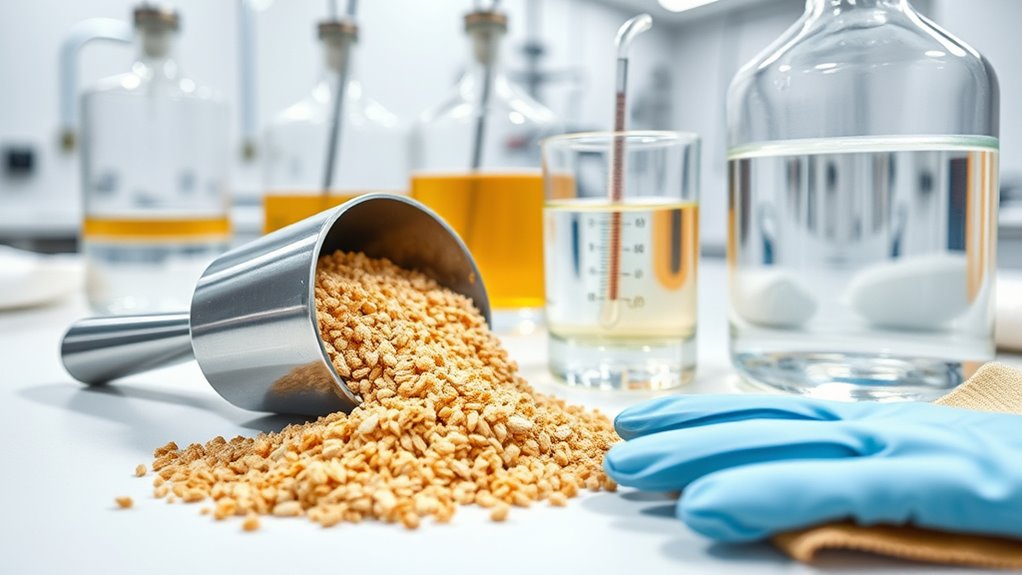
Cleanliness is vital in brewing equipment, as it helps prevent microbial growth and contamination that could negatively impact the flavor and quality of your beer.
All surfaces in contact with wort, beer, or yeast require regular cleaning and sterilization. Quickly cooling wort post-boiling is essential; make certain your cooling system remains clean for sterility. Proper sanitization methods, such as heat-based sanitization, are critical to eliminate any microbes that could spoil your brew.
Regular maintenance eliminates dust and soil that can introduce contaminants. Implementing quality control systems allows you to monitor yeast health, identifying potential issues early.
Helpful Hints:
- Clean equipment after each use.
- Sterilize cooling systems regularly.
- Monitor yeast health consistently.
Proper Yeast Pitching Techniques
After ensuring your brewing equipment is clean, the next crucial step involves proper yeast pitching techniques.
Start by performing a vitality test on your yeast to prevent future fermentation issues. Pitch yeast at an ideal temperature of 18-24°C to promote healthy fermentation.
Don’t forget to adequately oxygenate the wort; this supports yeast health and performance. Aim for a pitching rate of 0.75 to 1 million cells per milliliter per degree Plato, ensuring enough yeast for effective sugar fermentation.
Finally, pitch your yeast within 24 hours of cooling the wort to minimize bacterial contamination and kickstart fermentation strongly. Monitoring specific gravity is also essential to track fermentation progress and ensure quality throughout the brewing process.
Monitoring Fermentation Conditions
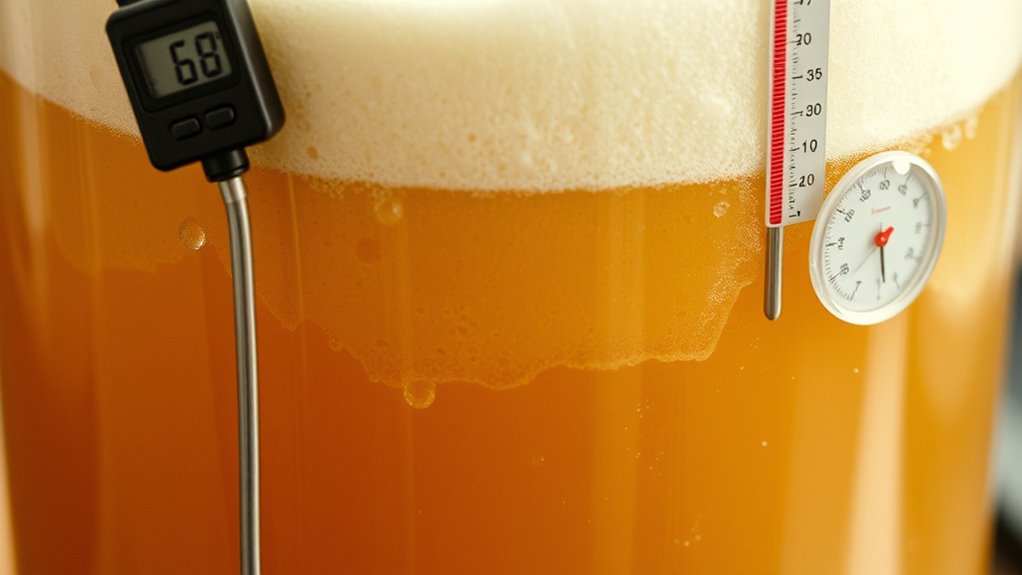
Monitoring fermentation conditions is essential for ensuring a successful brewing process. To maintain yeast health, regularly check temperature and oxygen levels, as high temperatures can increase nutrient demand and low oxygen can stunt yeast growth.
Use microscopic examinations to assess yeast health and viability, which helps detect potential fermentation issues early. Additionally, track fermentation progress with specific gravity measurements to identify stalls or inconsistencies, enabling timely adjustments.
Consistent monitoring of dissolved oxygen levels is critical for ideal yeast performance, so prioritize these checks. By effectively monitoring fermentation conditions, you can achieve a higher quality beer and avoid brewing disasters. Maintaining a stable temperature range is crucial to prevent excessive heat that can lead to yeast stress and fermentation issues.
Preventing Contamination and Infections
When brewing, it’s essential to recognize that preventing contamination and infections is key to producing high-quality beer.
Start by ensuring that your brewing equipment is thoroughly cleaned and sanitized, as any residue can introduce unwanted bacteria. Quick pitching of yeast after cooling the wort minimizes exposure to contaminants; this helps maintain a sterile environment. Additionally, maintaining fresh, clean raw materials such as water, malt, and hops is crucial for minimizing contamination risks.
Remember, while storing yeast, keep it in a clean, cool place to preserve its viability. Regularly inspect your brewing area for any potential sources of contamination.
Following these steps will help you brew innovative, flavorful beers without the risk of spoilage or off-flavors.
Record-Keeping for Yeast Management
Effective record-keeping is essential for managing yeast during the brewing process, as it enables you to track yeast performance and maintain consistent beer quality.
By documenting yeast strains, pitch rates, and fermentation conditions, you can quickly identify potential issues, like stalls or off-flavors.
Documenting yeast strains, pitch rates, and fermentation conditions allows for swift identification of issues like stalls or off-flavors.
Don’t forget to include environmental factors, such as temperature and oxygen levels, since they greatly impact yeast behavior.
Regularly updated logs help troubleshoot fermentation inconsistencies, and tracking repitching frequency guarantees yeast is used within its efficient lifespan. Additionally, maintaining a detailed inventory of your yeast starter kit ensures that you have the necessary resources on hand for optimal brewing results.
This thorough approach to record-keeping not only enhances your brewing process but also fosters innovation in your craft.
Understanding Yeast Viability and Vitality
To guarantee successful fermentation, it’s crucial to comprehend the concepts of yeast viability and vitality.
Yeast viability measures the percentage of live yeast cells in a sample, while vitality reflects their health and metabolic activity. A high level of dead cells can cause sluggish fermentation and off-flavors.
To maintain ideal yeast viability, confirm adequate nutrients, including sugars, nitrogen, vitamins, and oxygen. Additionally, proper storage conditions, like cooling yeast to 2°-4°C and using sterile water, greatly enhance viability.
Helpful Hints:
- Assess yeast viability using Methylene Blue.
- Monitor nutrient levels regularly.
- Store yeast correctly.
Best Practices for Yeast Propagation
Successful yeast propagation hinges on creating the right growth conditions, which include managing temperature, oxygen levels, and nutrient availability.
To guarantee optimal yeast health, follow these best practices:
- Maintain sterile, airtight containers to prevent contamination.
- Regularly measure yeast viability with a haemocytometer or microscopy.
- Track the number of repitches and yeast strain performance to avoid overworking.
- Confirm nutrient availability, as yeast requires specific nutrients for vigorous growth.
Troubleshooting Common Yeast Issues
How can you effectively troubleshoot common yeast issues during fermentation?
Start by conducting regular yeast health checks, including microscopic examinations and cell viability tests. This helps prevent sluggish fermentation and off-flavors.
Conduct regular yeast health checks to prevent sluggish fermentation and off-flavors, ensuring a successful brewing process.
Guarantee proper nutrient management, providing adequate nitrogen and vitamins to avoid stalls.
Keep accurate records of yeast strain usage and repitching frequency to track viability.
Store yeast in sanitized, airtight containers under CO2 at cool temperatures to maintain health.
Finally, always pitch yeast promptly after cooling wort to minimize bacterial growth.
